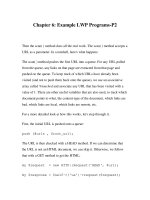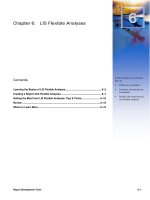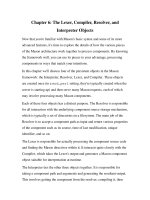Chapter 6 Trigger Store Procedure Function Cursor in Oracle
Bạn đang xem bản rút gọn của tài liệu. Xem và tải ngay bản đầy đủ của tài liệu tại đây (787.21 KB, 39 trang )
Chapter 6 (cont.):
Trigger, Store Procedure,
Function & Cursor in Oracle
Jan - 2014
Contents
1
Trigger
2
Store Procedure & Function
3
Cursor
2
Contents
1
Trigger
2
Store Procedure & Function
3
Cursor
3
Trigger Overview
A trigger is a procedure which is executed
implicitly whenever the triggering event
happens.
Executing a trigger is to “fire” the trigger.
Triggering Events are:
DML Commands: INSERT, UPDATE, DELETE
DDL Commands : CREATE, ALTER, DROP
Database Events: SERVERERROR,
LOGON, LOGOFF, STARTUP, SHUTDOWN
Trigger Overview
Uses for triggers:
Automatically generate derived column values.
Maintain complex integrity constraints.
Enforce complex business rules.
Record auditing information about database
changes.
Invoke a program when database changes.
Simple DML Trigger Syntax
CREATE [OR REPLACE] TRIGGER schema.trigger_name
BEFORE | AFTER | INSTEAD OF
DELETE | INSERT | UPDATE [OF columns list ] [OR …]
ON schema.table_name
[REFERENCING OLD [AS] <old_name> | NEW [AS]
<new_name>]
[FOR EACH ROW]
[WHEN (condition)]
BEGIN
PL/SQL_block | call_procedure_statement;
END trigger_name;
6
Types of Triggers
Category
Values
Comments
DML
Insert
Type of DML which makes the
trigger fire.
Update
Delete
Timing
Before
When the trigger fires.
After
Instead of
Level
Row
Row level triggers fire for each
affected row.
Identified by keywords FOR EACH
ROW
Statement
Statement level triggers fire once
per DML Statement
Trigger Firing Order
1. Before statement triggers fire.
2. For Each Row:
A) Before row triggers fire.
B) Execute the Insert/Update/Delete.
C) After row triggers fire.
3. After statement triggers fire.
8
REFERCING Clause: Old and New
Data
When row-triggers fire, there are 2 pseudorecords created called new and old.
new table_name%ROWTYPE;
old table_name%ROWTYPE;
old and new are of datatype ROWTYPE from
the affected table. Use dot notation to
reference columns from old and new.
old is undefined for insert statements.
new is undefined for delete statements.
9
REFERCING Clause: Old and New
Data
Instead of a REFERENCING clause, Oracle
assumes that new tuples are referred to as
“new” and old tuples by “old.”
Also, for statement-level triggers: “newtable”
and “oldtable”.
In actions, but not in conditions, you must
prefix “new,” etc., by a colon
:new
:old
10
Example: Row Level Trigger
CREATE TRIGGER NoLowerPrices
AFTER UPDATE OF price ON Product
FOR EACH ROW
WHEN (old.price > new.price)
BEGIN
UPDATE Product
SET price = :old.price
WHERE p_name = :new.p_name;
END;
Bad Things Can Happen
CREATE TRIGGER Bad_trigger
AFTER UPDATE OF price ON Product
FOR EACH ROW
WHEN (new.price > 50)
BEGIN
UPDATE Product
SET price = :new.price * 2
WHERE p_name = :new.p_name;
END;
Contents
1
Trigger
2
Store Procedure & Function
3
Cursor
13
Database Stored Procedures
Stored procedures
Program modules stored by the DBMS at the
database server
Can be functions or procedures
Persistent stored modules
Stored persistently by the DBMS
14
Stored Procedures & Functions
Useful:
When database program is needed by several
applications
To reduce data transfer and communication cost
between client and server in certain situations
To enhance modeling power provided by views
15
Stored Procedures & Functions
Declaring stored procedures:
CREATE [OR REPLACE] PROCEDURE
procedure_name
[(parameter_name [IN | OUT | IN OUT]
datatype )]
{IS | AS}
BEGIN
procedure_body
END procedure_name;
16
Stored Procedures & Functions
Parameter:
Data type: one of the SQL data types.
Parameter mode: IN, OUT, or IN OUT
IN: you must supply a value for the parameter when
calling the procedure.
OUT: procedure passes a value for this parameter back
to its calling environment after execution.
IN OUT: you must supply a value for the parameter
when calling the procedure and that the procedure
passes a value back to its calling environment after
execution.
Defaults: IN.
17
Stored Procedures & Functions
Example of store procedure:
CREATE OR REPLACE PROCEDURE update_salary
(p_emp_id IN EMPLOYEE.SSN%type,
p_factor IN NUMBER)
AS
v_emp_count INTEGER;
BEGIN
SELECT COUNT(*) INTO v_emp_count
FROM employee
WHERE SSN = p_emp_id;
IF v_emp_count = 1 THEN
UPDATE employee
SET salary = salary * p_factor
WHERE SSN = p_emp_id;
COMMIT;
END IF;
END update_salary;
18
Stored Procedures & Functions
Calling a store procedure:
EXECUTE update_salary (‘123456789’, 1.5);
BEGIN
update_salary (‘123456789’, 1.5);
END;
19
Stored Procedures & Functions
Declaring function:
CREATE [OR REPLACE] FUNCTION function_name
[(parameter_name [IN | OUT | IN OUT]
datatype )]
RETURN datatype
{IS | AS}
BEGIN
function_body
END function_name;
20
Stored Procedures & Functions
Example of Function:
CREATE OR REPLACE FUNCTION get_salary
(p_emp_id IN EMPLOYEE.SSN%TYPE)
RETURN NUMBER
AS
v_sal NUMBER;
BEGIN
SELECT salary into v_sal
FROM EMPLOYEE
WHERE SSN = p_emp_id;
RETURN v_sal;
END get_salary;
21
Stored Procedures & Functions
Calling a function:
SELECT * FROM EMPLOYEE
WHERE salary = get_salary (‘123456789’);
SELECT get_salary (‘123456789’) FROM dual;
22
Contents
1
Trigger
2
Store Procedure & Function
3
Cursor
23
Database Access Using Cursors
When the result of an SQL query (select
statement) consists of more than one row,
the simple select into statement can not be
used.
A PL/SQL cursor allows the program to fetch
and process information from the database
into the PL/SQL program, one row at a time.
24
Explicit Cursor
Explicit cursor: used for processing a query
resulting in more than one row.
Implicit cursor: is automatically defined by
PL/SQL for the select into statements, which
result in one or fewer rows.
Syntax of explicit cursor:
cursor <cname> [return-spec]
is <select-statement>;
25









